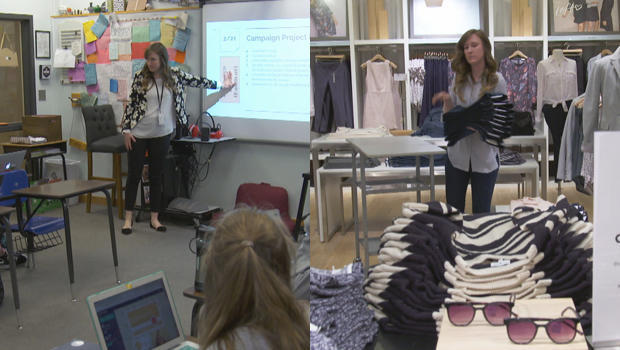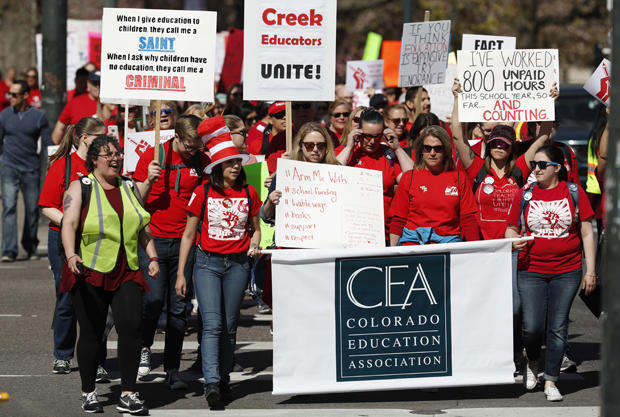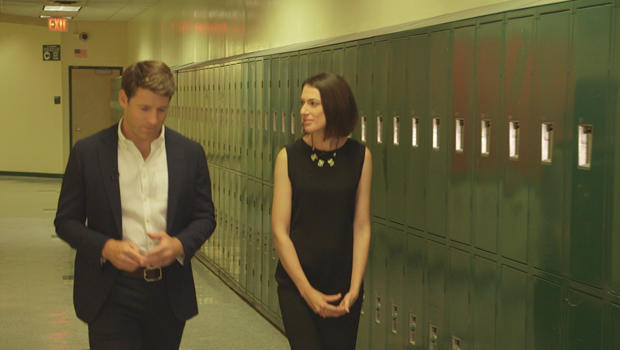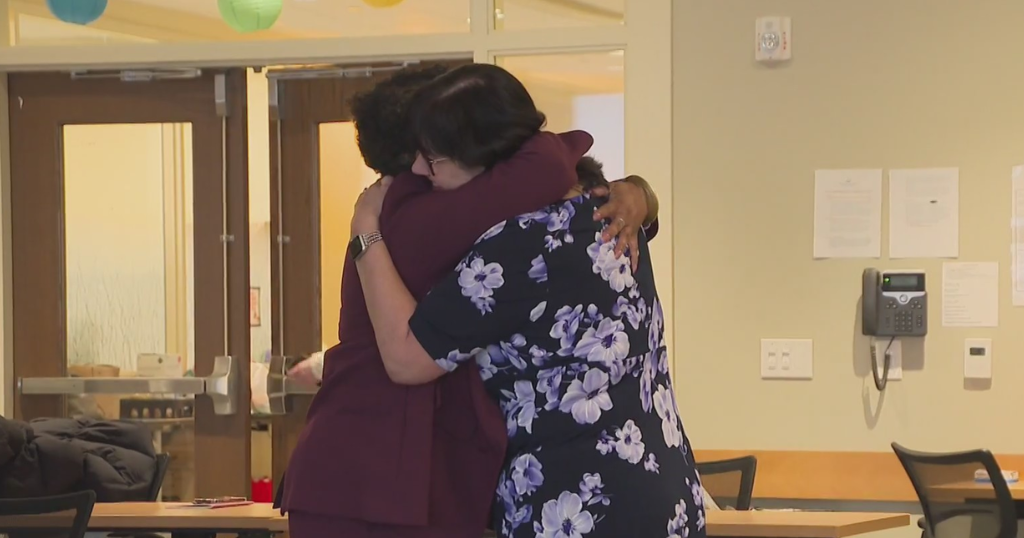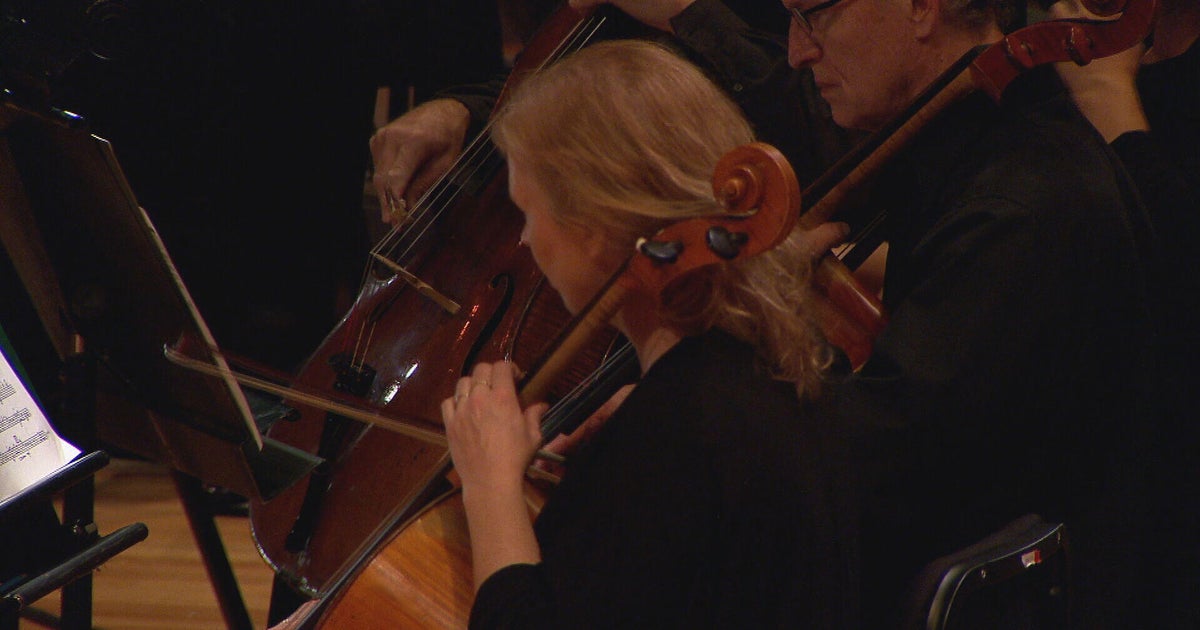How we have failed our teachers
There's no denying that summer is over, and that means "back to school" — a time when many of Kara Stoltenberg's high school English students in Norman, Oklahoma, have put their summer jobs behind them to focus on school. Her? Not so much.
"You have a whole day of school and then you come here?" asked "CBS This Morning" co-host Tony Dokoupil.
"Yes, I do," Stoltenberg replied. "Get to school typically around 8:00. Technically off the clock at around 4:20, finish things up at school, and then head over here."
"Here" is the mall, where she works a second job at Loft.
The 28-year-old had a retail job back in college, but after getting a master's degree, she thought those days were behind her: "People kept telling me the same thing, 'The pay's not great, the pay's not great.' And I heard that and I understood that. I don't think anyone could have really prepared me for how close I would be cutting it."
Nationwide about 1 in 5 teachers (or 18%) have a second job during the academic year, which is not so surprising when you consider that, since 1996, inflation-adjusted pay for a public school teacher has actually fallen by 1.7%. The average annual teacher salary today: just over $60,000, with nearly a third of teachers (31%) making less than $45,000 a year.
Fury over those flat and falling wages helped spark a movement, one that in the last 18 months swept through conservative red states and liberal blue cities, as tens of thousands of teachers walked off the job.
"They feel that the expectations for them have risen and their pay has really not kept up," said Dana Goldstein, an education reporter for The New York Times and author of the 2014 book, "The Teacher Wars: A History of America's Most Embattled Profession" (Anchor Press). She said low pay has been a problem for teachers since the early 1800s, a time when most teachers in America were men.
"When it came time to have universal public education for all American kids, Horace Mann, the father of our public school system, said, 'I have an idea: Let's bring women in as teachers. Then we can expand public education and it will not cost quite as much."
"Because we don't have to pay women as much?" said Dokoupil.
"Exactly. At that time, it was legal — you could pay women half as much."
But Goldstein said the recent strikes are about more than just pay; she says many teachers simply don't feel respected.
And it's a feeling she traces back to a landmark 1983 report from the Reagan Administration: "A Nation at Risk." The report stated: "If an unfriendly foreign power had attempted to impose on America the mediocre educational performance that exists today, we might well have viewed it as an act of war."
Goldstein said, "One of the arguments it made was that, you know, teachers, and the sort of low-intellectual capacity of some teachers, was to blame for kids having low test scores and not being able to compete internationally."
"So, it wasn't only that schools were failing, it was teachers are failing?" asked Dokoupil.
"Yes," said Goldstein. "It was a big change. And I think for many teachers that was the beginning of feeling that they were being unfairly portrayed and unfairly treated by policy makers, by politicians."
As new mandates to improve test scores, track student progress, and justify every lesson were piling up, everyone else, it seemed, piled on.
In January 2011, President Barack Obama said, "We want to reward good teachers and stop making excuses for bad ones."
Inside his fourth-grade classroom near Tulsa, Oklahoma, Eric Weingartner felt like he was making a difference. "When I was in that classroom, I was the best teacher they could ever have," he said. But increasing demands from outside the classroom got in the way.
"When I first started teaching, like, you might have one meeting a month," he said. "When I left, you would have two meetings a week. You'd also have two meetings during the school day. You might have one before. And the amount of paperwork is insane."
And the hours? "Well, that's where they kind of trick you, like, 'You get summers off, you get every vacation off, and you're only there for seven hours a day.' But that is not true at all. What you don't see behind the scenes is all the other things that are required of you that take up your time.
"So yes, students might've left the classroom. But you will be there before they get there, and you'll be there long after."
And it was challenging to do it all on a teacher's salary in Oklahoma. "When we bought our first house, the only way we could afford it was, we had to take on multiple jobs. I worked at Sears. I'd also worked as the janitor at the school district, too. So, I would get out of school, I would change my clothes, and then go right to janitor work. And I'd do that 'til about 9:00, 9:30."
When Oklahoma's teachers walked out last year, they hadn't had a raise in a decade. And when they returned after 10 days, the raise they got fell thousands of dollars short of what they'd asked for.
Weingartner said, "I'm not waiting another ten years for $6,000. No way."
And so, after 15 years as a teacher, the 40-year-old left the profession. He now works in a factory making $12,000 more a year. Thirty-thousand teachers like Weingartner have left Oklahoma classrooms in the last six years alone, part of a nationwide trend contributing to teacher shortages all over the country.
- Teacher shortages worsening in majority of U.S. states, study reveals (The Guardian, 9/6/2018)
Kara Stoltenberg said the exodus is hard to watch. "In the English Department, we've lost 26 teachers in five-and-a-half years," she said, getting emotional. "And they're teachers who love this career. And the most painful part is that students are the ones who feel it. Like, they get attached to those teachers. They look forward to having them. And I have students telling me I should leave."
"Where does that come from?" asked Dokoupil.
"I think it's because they care, and they see how hard we work."
Former Oklahoma teacher Carri Hicks also decided to give up teaching, but she didn't give up on education: "I was meeting with senators who were serving on the Education Committee. And I said, 'Hi, I'm Carri Hicks. I'm a fourth-grade math and science teacher at Dear Creek Elementary, and this year I have 28 students.' And he put his hand up and told me I was lying.
"And he said, 'Well, we know that the average class size in Oklahoma is 16.' And I said, 'I don't know where you're getting your numbers, but I've been in education in Oklahoma for seven years, and I've never had a class size less than 23.'"
Dokoupil asked her, "So, what did you decide in that moment?"
"That if they were unwilling to do the job, then I could do it better," Hicks replied.
Her response:
She ran for the state senate in Oklahoma – one of dozens of teachers who ran for political office all across the country last year. The results were mixed, but Hicks won her race decisively, and vows to keep fighting for higher pay for Oklahoma's teachers.
"If we're not willing to put more dollars into the classroom, if we're not willing to invest in the people that are going to be at the front of those classrooms either, then what is left for public education?" she said.
Polls show that when teachers strike for higher pay, their communities overwhelmingly support them. But consider this: When given the chance to actually pay teachers more by approving tax increases, very often those same voters say no.
- Voters defeat parcel tax to fund L.A. schools (KQED, 6/5/19)
- Colorado Amendment 73: Voters reject $1.6 billion school tax measure (Denver Post, 11/7/2018)
Until that changes, Kara Stoltenberg says many teachers will continue to struggle so their students won't have to.
"Anytime I think about my job, I picture my students. I don't want them to suffer at all because of restraints I have," Stoltenberg said. "Maybe that's why we're not getting the funding. We're not getting the raises necessarily that we need, because we still make it work and we do what we need to."
For more info:
- Dana Goldstein, The New York Times
- "The Teacher Wars: A History of America's Most Embattled Profession" by Dana Goldstein (Anchor Press), in Trade Paperback and eBook formats, available via Amazon
- State Senator Carri Hicks, District 40, Oklahoma
Story produced by Mark Hudspeth.
